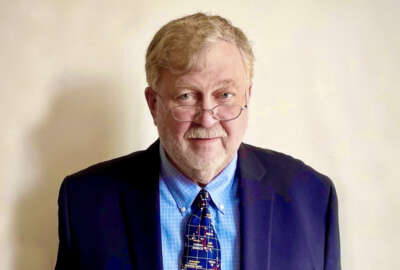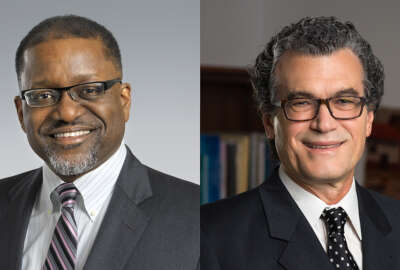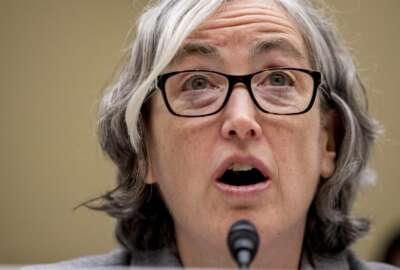
NIH doctors earn Sammies finalist honors for addressing higher COVID-19 rates among minorities
Black, Latino, Native American and other minorities had higher rates of COVID-19 - contracting it and and being hospitalized - than the national average. Last...
Best listening experience is on Chrome, Firefox or Safari. Subscribe to Federal Drive’s daily audio interviews on Apple Podcasts or PodcastOne.
For a variety of reasons, many Black, Latino, Native American and other minorities had higher rates of COVID-19 – contracting it and being hospitalized – than the national average. Last summer, Dr. Gary Gibbons decided to do something about it. He’s the director of the National Heart, Lung and Blood Institute at the National Institutes of Health, and he’s a finalist in this year’s Service to America Medals (Sammies), along with Dr. Eliseo J. Pérez-Stable, director of the National Institute on Minority Health and Health Disparities. Gibbons spoke to Federal Drive with Tom Temin for more.
Interview transcript:
Tom Temin: Dr. Gibbons, good to have you on.
Dr. Gary Gibbons: Thank you very much for having me.
Tom Temin: And we should also note that your co-recipient of this award could not be with us this morning. That’s Dr. Eliseo J. Pérez-Stable. And he’s the director of the National Institute on Minority Health and Health Disparities – so your co recipient there. But first of all, set the scene for us. What was the issue that you identified among certain communities at the height of the pandemic?
Dr. Gary Gibbons: Well, Tom as you remember, a year ago, over a year ago now, in the early spring of 2020, it was clear that COVID-19 was devastating and disrupting our whole society. But there were certain communities that were even more disproportionately affected than adversely affected by this pandemic. Indeed, it really laid bare health disparities that have been long existing with those most vulnerable communities, really getting the brunt of the pandemics impact. Those involve communities of color that you alluded to African American, American Indian, Latino communities that had two fold full higher risks of hospitalizations, deaths. And that related in part to a couple of factors, some of which we call the social determinants of help. Those communities often have workers who are essential in the front lines, and therefore are highly exposed to the virus, whether it’s because they work in grocery stores, or the transportation industry, or hospitality industry, they came in contact with the virus, and quite frankly, were vulnerable and not having the protection. And so that’s where that greatest burden was born. They also had difficulty accessing testing, and treatments and so forth. And so that’s where we felt that as part of the overall response of the NIH to COVID-19, that a critical element of that response would involve an important community engagement of those communities, to see what we could do to enable empower them to protect themselves. And that’s what led to the launch of the two programs, the NIH Community Engagement Alliance Against COVID-19 Disparities, or the CEAL program – as well as a more targeted program focused on testing.
Tom Temin: Alright, we’ll get into the details of those programs. But I just had a follow up question, these populations that we’ve been discussing, there’s also a historic maybe reluctance on some of those people’s parts to come near the medical community or to seek the help they need because of, I guess you could call it a trust issue – correct?
Dr. Gary Gibbons: Yeah, it’s an important point. This again evolves out of really, again, many years in which maybe these communities have developed a certain mistrust. And, quite frankly, it has some legitimacy in terms of their own personal experiences with racial discrimination when they interface with the health system, perhaps in an emergency room, where they don’t feel as though they’ve been treated equitably. And indeed, research has confirmed some of those impressions. And so that tends to hinder rapid trust and uptake of new either treatments, or engagement in a context of a pandemic like this. So you’re absolutely correct. Similarly, your audience probably aware of sort of historical research done by the government. Actually, the Tuskegee syphilis study is the most famous in which the research community also failed some of these same communities in exploitative way that, again, eroded trust. And so it’s in the context of those where we need to do research and ensure that the scientific benefits reach these communities, all in the midst of the same pandemic, given those historical legacy issues.
Tom Temin: We’re speaking with Dr. Gary Gibbons, director of the Heart, Lung and Blood Institute at the NIH, and along with Dr. Eliseo Pérez-Stable, a finalist in this year’s Service to America Medals program. And tell us about these two programs, the CEAL program and the RADx-UP, that were devised for NIH to attack these problems. Tell us about – let’s start with the CEAL program.
Dr. Gary Gibbons: Sure, well CEAL, the Communities Alliance Against COVID-19 disparities, is really a community centered response to ensure that the hardest hit communities have – number one, accurate information and to access to the fruits of COVID research that ultimately resulted in vaccines, and to ensure that the products of that research like vaccines, effectively is taken up in a way that eventually prevents the ongoing spread of the pandemic in those communities, and is part of the overall strategy to crush COVID-19 in this country, and so you Clearly a key part of that was developing partnerships and alliances designed to meet people where they are at the frontlines at the grassroots and engage trusted messengers who live and work and play and, and worship in those communities to convey that accurate information, and again, tried to address both mistrust and misinformation that was, quite frankly, quite rampant last summer and fall.
Tom Temin: Interestingly, this seems to borrow in part a page from the Census Bureau, which also has outreach to specific communities that often don’t speak English, or it’s not their native language, such that they have faith in the fact that the census is being conducted in an equitable, fair way, and they’ve got nothing to worry about.
Dr. Gary Gibbons: Good point, again, Tom. And often, it helps if the individuals who are literally knocking on doors or meeting them where they are, look like them are part of their community. I think that in genders that sense of trust, and perhaps resonance with those messages, because they are familiar individuals, there may be a local pastor, a local doctor, or neighbor. And so that’s what these teams of researchers and Coalition’s with community based organizations, faith based organizations really rank and file grassroots organizations that are already known in those communities that are then mobilized toward this effort of public health protection of that community. I think that’s a key part of being able to engage them.
Tom Temin: And once they are engaged, then you have the RADx-UP program and tell us about that one.
Dr. Gary Gibbons: Yeah, so RADx-UP is really to get sort of rapid movement of diagnostic that’s really part of the RAD part of it, and recognizing that there’s some barriers related to accessing things like testing, and contact tracing, and eventually other forms of access to care. And so RADx-UP involved the NIH effort to fund over 70 community engaged research projects designed to address how can we overcome those barriers of mistrust and dissemination. And so for one example, theoretics, up to make available testing through social networks of people so that indeed, if you find that your neighbor is getting tested, you’re a bit more likely behaviorally, to be nudged into getting tested yourself, and addressing any fears or concerns related to or understanding the logistics of navigating a system. And so both RADx-UP up and CEAL use those sort of local navigators, if you will, in champions to advance the uptake of these beneficial technologies and treatments.
Tom Temin: And now a year on, do you have evidence that this all worked for those communities?
Dr. Gary Gibbons: Well, these are still early days in our program evaluation. But what I think is fair to say is that when we launched these efforts, particularly CEAL in last fall, the level of hesitancy amongst African Americans was quite substantial. Only 40% said that they would take the vaccine shown to be safe and effective, and that was far lower than whites. At that time, which were in the 60s, or the screw the majority, that gap is almost trumped to less than 10. It’s not zero now, some six months later, and we believe that reflects this kind of multi level, full court press, if you will, of messaging, both at the national level with leaders like Dr. Fauci and the Surgeon General, but as well at this local level, with the same messages are being carried, as you say, by trusted local messengers, whether it’s their congressperson or their pastor, whether it local doctor who they already have trusted relationships with, and we believe that that change is reflective of that sort of multi pronged effort.
Tom Temin: Dr. Gary Gibbons is director of the Heart, Lung and Blood Institute at the NIH, and along with Dr. Eliseo Pérez-Stable, he’s a finalist in this year’s Service to America Medals program. Thanks so much for joining me.
Dr. Gary Gibbons: It’s really been my pleasure, Tom. Thank you.
Copyright © 2025 Federal News Network. All rights reserved. This website is not intended for users located within the European Economic Area.
Tom Temin is host of the Federal Drive and has been providing insight on federal technology and management issues for more than 30 years.
Follow @tteminWFED
Related Stories





